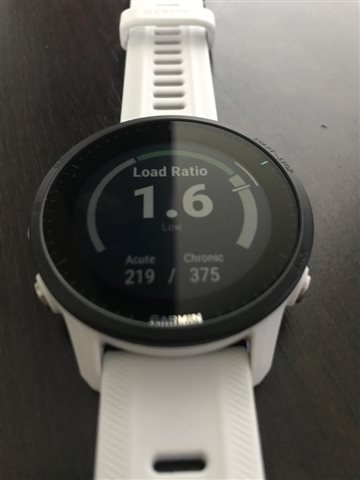219 / 375 = 0.6
375/ 219 = 1.7
You had one job, Garmin!

The Load Ratio is an implementation of a concept in sport science called Acute-Chronic Workload Ratio (ACWR). There are two models in ACWR: rolling average (RA) and Exponentially Weighted Moving Average (EWMA). Rolling average does what it says: it takes the recent average load per day (say, past 7 days), and divides it by the long-term average load per day (say, past 28 days). The exponentially weighted moving average is similar to the rolling average, but gives more weight to more recent trainings, so an unusually light training 8 days ago will increase the ratio significantly, while an unusually light training 4 weeks ago will barely impact the ratio at all.
It's not clear which method Garmin has implemented, but it's possible some of the most recent workouts in the 'chronic' category were lighter, pushing the ratio higher.
Note that the ACWR concept had a period of popularity but has since been criticized as statistically unable to 'predict' injury: Impellizzeri, F., et al. (2020). Acute to random workload ratio is “as” associated with injury as acute to actual chronic workload ratio: time to dismiss ACWR and its components.SportRxiv (preprint).
It seems a bit too coincidental that the 3 users in this thread with weird values all have 1.6 load ratios for this to just be a difference of how Garmin calculates. It shows us the acute and chronic loads underneath used to do the calculation.
219/375 = 1.6 (expected would be 0.5)
550/536 = 1.6 (expected would be 1.0)
635/517 = 1.6 (expected would be 1.2)
Thank you - they may well be using Exponentially Weighted data then.
I had presumed Garmin would use Firstbeat's ratio. https://www.firstbeat.com/en/blog/interpreting-acute-vs-chronic-training-load-a-firstbeat-sports-feature/ on their examples all the ratios are "correctly" calculated.
